Dungeons and Dragons News site follow us at lichlair.com
Don't wanna be here? Send us removal request.
Photo

Checkout our new post over at https://lichlair.com/soulknife-rogue-lets-talk-about-it
Soulknife Rogue: Let's Talk About It
Alright so unless you’ve been living under a rock for the past few months or you just so happen to be one of those people who are, you know, not locked at home relearning how to crochet in this near apocalypse…then you’ve probably at least seen pictures of WotC’s brand new book: Tasha’s Cauldron of Everything. Not only is this book heavily packed with content that’s got all my players messaging me about (yeah, we hopped on that Discord too), but it also made a few of the more popular 2019 UAs official. More specifically, of course I am talking about those nice psionic subclasses we wrote about a while ago, which is why today we’re taking a look at some of the changes made to the Soulknife Rogue. If you’re curious about what this subclass looked like before going official, you can check out my original article over here.
Definitely not biased perspective
Well, for starters, I actually got to play a Soulknife for D&D’s most recent adventure, Icewind Dale, Rime of the Frostmaiden, which means that I can now give an update on my thoughts that I will succintly summarize in three words: f**k, that’s fun!
From experience, I can now say that this is probably the second most fun I’ve had playing a rogue (and I play my fair share of rogues!). Not only does the whole psionic abilities flavor really well and offer cool thematics for you to build on for your character, but they also make for some great utility:
I must admit that when I first read through the UA version of the Soulknife I didn’t quite appreciate how valuable the vanishing properties of our new weapon of choice would be but now I can confidently say: move over Assassin rogue! Why would anyone need to spend weeks working on a persona when you can just make your weapons leave no trace on your marks? Definitely a big game changer for those of you out there who might be considering playing a sneaky assassin/hitman sort of character.
Another great bit of utility I’ve found even more helpful than I anticipated is actually the Soulknife rogue’s ability to communicate with other creatures. Sure, the rogue’s 3rd level Psychic Whispers is great for coordinating party movements as is, but one mustn’t dismiss the specific wording in the text! “Creature” implies that you can talk to just about anything that moves as long as it has a language. It doesn’t even matter if your character can’t speak said language! I know I say this often but… Pact of the Great Old One who? This is such a useful ability that has gotten my party out of trouble on many occasions. Got an angry Yeti yelling at you? Just chat it up!
What’s changed
Whether you are just now looking to play this class or simply looking for a breakdown of the changes to update your sheet with, we can definitely say there’s a lot going on with this first official print of the Soulknife Rogue. Here’s the gist of it:
Psychic Blade, 3rd level
Then: In the 2019 UA version, summoning 1 to 2 blades (our choice) required the usage of our bonus action. While not the worst, this was certainly less than ideal for the heavily B.A reliant rogue class. Now: Lucky for us, summoning a blade is now part of our action (and bonus action if we so choose). Not only does free up our action economy, but it also allows us to make that stabby stabby thing rogues are known for. As a note, while the 1d6 psychic damage remains unchanged on our main attack, do keep in mind that our off hand is now only a 1d4.
Psionic Powers (Replaces Psionic Enhancements), 3rd level
Then: In the 2019 UA version, we had the choice of increasing our movement speed, giving ourselves some extra temporary hp, or mentally communicating with a single creature within a 30ft rage of us. As well as the ability to switch between these three options on a long rest.
Now: We get psionic dice! Our 1d6 (increases as we level up) now allows us to communicate telepathically with a number of creatures equal to twice our proficiency modifier at the same time! Be the moving walkie talkie set you always wanted to be. Not only that, but the distance of our range also substantially increases to a mile. The only caveat to this ability and that the duration of this connection is limited in hours equal to the number we roll on our psi die. Another potential downgrade is that creatures can now choose to end this communication of their free volition.
“Please, stop playing 80s jams on a loop”
Last but not least, while we might not longer be able to increase our movement speed or acquire temporary hit points, Soulknife rogues are now able to roll an added dice when rolling checks they’re proficient in, thanks Psi-Bolstered Knack!
Soul Blades (Replaces Terrifying Blades), 9th level
Then: In the 2019 UA, we could strike fear into our opponents hearts with our blades (or you know, your rogue-y edge) by forcing them to make a wisdom saving throw on a hit.
Now: We get two options; Honing Strike allows us to add our psi die to our attacks once we know we have missed, which, as if this subclass weren’t OP already, wording would indicate only happens if the added die value lands us the hit; that is, if it still misses, we get to keep our die. Talk about broken!
That’s not all, however, this official version of the subclass also gives us the ability to use our bonus action to throw a blade and teleport to the space it occupies. Think about it: tall building? Bamf! Need to clear a room quickly? Bamf! Baddie is getting away? Bamf! The only limitation to this ability is that we can only move up to ten time our roll on the psi die, which I suppose can be a little unpredictable.
Psychic Veil, 13th level
Then: In the 2019 UA, this ability allowed us to become invisible for up to 10 minutes or until we made an attack or forced a saving throw. This ability was available to us a number of times equal to our intelligence modifier and replenish on a long rest.
Now: What kind of stealth mission only takes 10 minutes? Doesn’t matter! This new version of the Soulknife allows for an entire hour’s worth of invisible shenanigans. Not only that, but the wording has been changed to that invisibility only breaks after dealing damage or forcing a saving throw. Prank your little rogue heart away. I suppose the only caveat to this is that we only get a single free use of this before having to spend our psi die to activate this feature.
Rend Mind, 17th level
Then: In the 2019 UA, the damage dealt by this feature was equal to 12d6 psychic damage and half as much on a save and could be used a number of times equal to our intelligence modifier that replenished on a long rest.
Now: While there is still a save to decided whether or not our target is stunned, the damage dealt by this feature is no longer halved and instead equals that of our sneak attack. Another change is the fact that we can now only use this feature once per long rest unless we are ready to part with three of our psi die to do so again.
I don’t know about you folks, but I definitely think we got an upgrade on this one and I personally cannot wait to keep plying the updated version of this subclass. Got any comments about the Soulknife you’re itching to share? Drop a message in the comments below!
4 notes
·
View notes
Photo
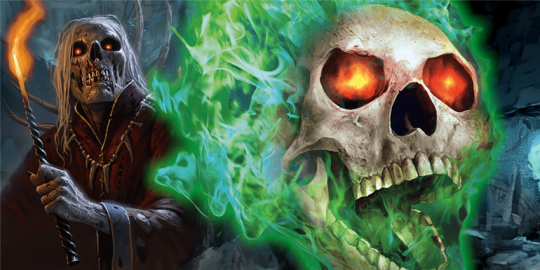
Checkout our new post over at https://lichlair.com/monday-monster-60-flameskull
Monday Monster #60: Flameskull

I’m very sorry if you got PTSD just from reading that title; I know many out there have suffered at the figurative hands of this monster, which is why I vow to dig deeply into its lore and statblock to see if we can reach some sort of redemption. Without any further ado, let us discuss the…

Flameskull
The basics
For a floating calcium deposit these things have surprisingly good stats; we’re looking at matching +0 CHA and WIS, a +2 CON, and a single dump stat assigned to STR for a -5 modifier. Today’s monster is both incredibly smart and incredibly dexterous with matching +3 scores to DEX and INT.

The Flameskull gets +5 to Arcana checks as well as a nice +2 to Perception for a total Passive Perception of 12. They also get 60ft of Darkvision and 40ft of hovering movement. Thanks to that big head of theirs they can also communicate in Common despite, you know, not having a tongue or any of the other important bits we use for talking.
In terms of combat durability, this thing can probably rival creatures of much higher CR. Its measly AC of 13 and average hit point pool of 9d4+18 might not look like much but today’s monster is immune or at the very least resistant to a wide variety of damages. We’re looking at Immunity to Cold, Poison, and Fire damage… you know, only the most widely used type of damage in the game, but as if that weren’t enough, they also have resistance to Lightning, Necrotic, and Piercing damages and cannot be charmed, frightened, paralyzed, poisoned, or prone.

But even now we’re not quite done yet; Flameskulls also have Magic Resistance for some nice advantage on saving throws, not to mention their Rejuvenation feature that will have them regain all their hit points back after being destroyed unless their magic is dispelled, or they get sprinkled with some of that good holy water. That’s a thing, yeah.
On the bright (ha!) side of things, your party of adventures won’t have to carry torches while they fight this thing because today’s monster does give off 15ft of dim light at a minimum (though it can choose to increase the range and brightness for a further 15ft).
As promised for ranger week, the Flameskull is fully reliant on range spell attacks, its main attack action being a Fire Ray that works with its Multiattack feature. Chances are though, that, before this creature goes down, you’ll want to use up the spells that it gets access to:
Cantrip (at will): mage hand
1st level (3 slots): magic missile, shield
2nd level (2 slots): blur, flaming sphere
3rd level (1 slot): fireball
That’s right, this thing has a goddamned Fireball waiting to go off. Not to mention the fact that it gets the option to use shield on top of all the crazy resistance it already gets. Actual bananas.
Last but not least, today’s monster is considered a tiny undead ans is usually of neutral evil alignment. Although this bit might be a little debatable, it is also technically a CR 4 creature.

The lore
The Flameskull was first introduced in volume one of the Monstrous Compendium for 2nd edition. As a monster that has been part of the game for most of its history, today’s monster has been through a handful of changes (mostly to do with the list of spells available to them) but remains the same when it comes to its lore. Speaking of older editions though, despite their very bright presentation, these monsters somehow managed to qualify as stealthy back in 4th edition, don’t ask me how though.
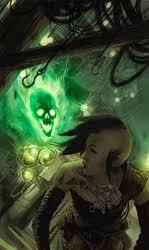
The first thing you should know about these creatures is that they aren’t born and have no way of reproducing amongst themselves. Flame skulls can only be fashioned from the skulls of recently deceased spellcasters or cultists, human wizards in particular, through a dark ritual performed by a powerful necromancer. The skulls themselves are often carved with esoteric runes and symbols.
After being summoned and bound to their master, Flameskulls will listen follow instructions to the letter until their purpose has been fulfilled. Oftentimes they will be used as guardians of particularly important places or treasure, but it’s not completely unheard of for them to be assigned to guarding a living being instead.
While Flamekulls will follow their master’s instructions unlike they can no longer follow them, they do retain a few aspects from their previous life; most notably their intelligence. It is also common for Flameskulls to have a similar spell list to the one they had while alive. The only way for Flameskulls to regain a semblance of autonomy is to complete their task. Of course by the time that happens most of them will have been driven mad by their long years of isolation safeguarding treasure.
Once freed, these creatures would show a curiosity for the world after years of duty. In fact, Flameskulls have been observed to follow adventurers around in search for excitement. In return, Flameskulls might choose to share some of the more obscure knowledge and lore they might have come across in their time as wizards.

The execution
Okay, hear me out. I think a lot of the reasons why people dislike this creature so much has to do with CR and level. Yes, fighting a Flameskull should be challenging, but there is a very steep curve for Fireball danger at this level. Which is why I want to put forward the idea that your party should not fight a Flameskull, but instead fight three of them.
If you have a higher level party!
My stance on this is this: Flameskulls should be used as minions against higher level adventurers. Take for example this encounter:
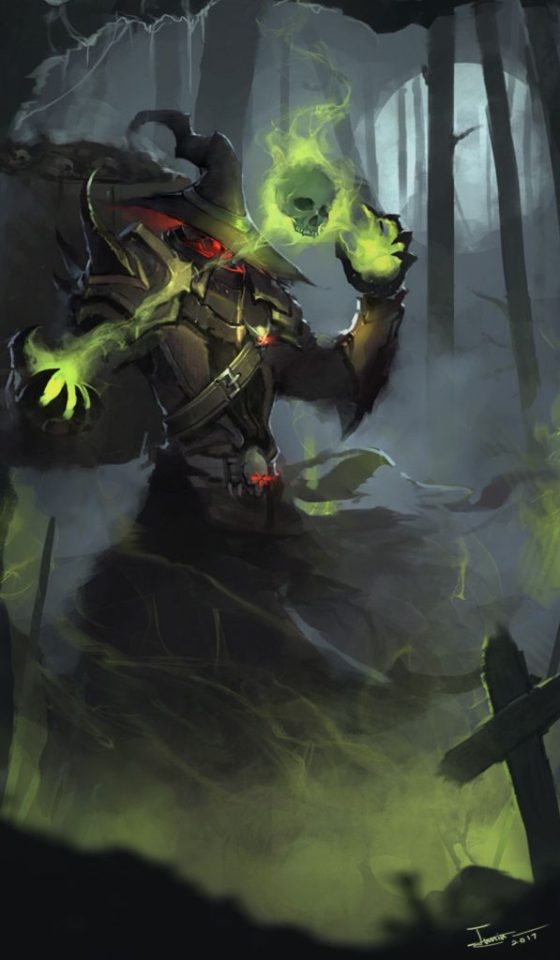
The party finally reaches the top of the evil necromancer’s spire, they trade snarky comments with our heroes, and bam! Our villain smirks and snaps their finger only to have three Flameskulls appear. Heck, it could even be an interesting premise for a villain: a powerful necromancer who is going around killing wizards only to raise them in servitude as Flameskulls.
Keep in mind Flameskulls aren’t only fun in combat situations either! Got a big bad you were fond of only to have your party of aventurers make quick work of them? Why not have them come back as an extra powerful Flameskull under the influence of your next big bad? You could even give them some especial armor or a particularly nasty spell list to toughen them up depending on your party level.
But even if you don’t have a big bad to bring back, Flameskulls can still be plenty fun in social encounters. The idea of luring the party into what appears to be a difficult encounter with a Flameskull only to have the creature start jabbering ridiculous riddles or pestering the party for the rest of the dungeon is extremely fun to me. If done right this creature would very well turn a would be mediocre dungeon into something memorable. Don’t believe me? Give it a try yourself!
If you enjoyed this article and would like to be updated whenever we post something new, don’t forget to follow us on our social media. If you have any interesting comments or funny anecdotes do leave us a message in our forums!
#Behind the Screen#Daily Monster#dnd#dnd5e#dndbeyond#dungeons and dragons#monday monster#Monday Monster
1 note
·
View note
Photo

Checkout our new post over at https://lichlair.com/spell-archive-conjure-barrage
Spell Archive: Conjure Barrage

Aha! I bet you thought we were going to talk about Hunter’s Mark for Ranger week huh? Think again! Have you ever met a ranger that didn’t pick up Hunter’s Mark as one of their spells? It’s basically the Eldritch Blast equivalent to rangers. Which is why today we’re going to be talking about a different Ranger-only spell…

Conjure Barrage
3rd-level conjuration
Casting Time: 1 action
Range: Self (60-foot cone)
Components: V, S, M (one piece of ammunition or a thrown weapon)
Duration: Instantaneous
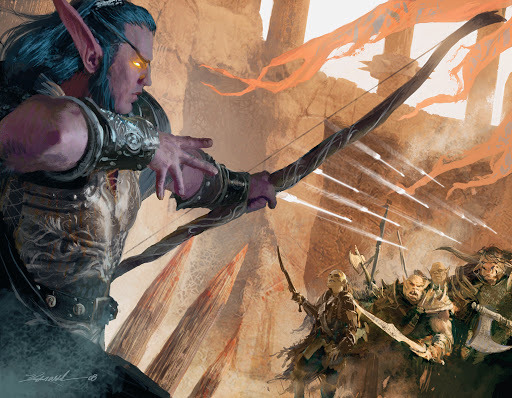
You throw a nonmagical weapon or fire a piece of nonmagical ammunition into the air to create a cone of identical weapons that shoot forward and then disappear. Each creature in a 60-foot cone must succeed on a Dexterity saving throw. A creature takes 3d8 damage on a failed save, or half as much damage on a successful one. The damage type is the same as that of the weapon or ammunition used as a component.
Spell Talk
Alright! So casting this spell will cost us a 3rd level spellslot which is actually quite a bit of an investment for a half-caster. By the time we reach level 9 and unlock 3rd level spells 3d8 might not sound like a lot, but we have to keep in mind that this attack will affect everything in a 60ft cone, even if some of the enemies do make the save. Speaking of 60ft range, while this distance pales in comparison to the usual longbow range, notice that the spell only asks for non-magical weapons, which means we could turn our measly dagger range into something wonderful. Since we’re on the topic of daggers though, do keep in mind that this spell affects everything in a 60ft cone…that definitely includes your allies!
Last but not least, it’s also a good idea to remember that DEX saves are one of the most common types of saves in the games and a such many monsters have pretty decent dexterity scores.
Tips and Tricks
…which is exactly why you should consider having the wizard slow your enemies before you cast this. You know, if the stars align for it. At the very least you should keep an eye out for meaty creatures that look like they might have trouble getting out of bed in the morning, these will be your safest bet to hit. On the other hand, you’d do well to avoid using this spell against dexterous creatures, but even then, depending on the number of targets it might still totally be a worthy investment.
Imagine Cloud of Daggers, but better..
Now let’s backtrack a little, you know that bit that doesn’t specify the kind of weapon you can use for this as long as it isn’t magical? That bit? How would you feel about making it rain…. chairs. All you gotta do is take the Tavern Brawler feat and you’ll be able to use just about any mundane item for this spell since they will all technically be considered weapons for you.
Reflavor
The beauty of this spell is that you don’t even need to go out of your way to reflavor it since you can technically use any weapon for it, especially if you do go with Tavern Brawler. This opens up untold possibilities of customization for all flavors of rangers. You want to make it rain shurikens? Easy. But even if you choose to lean more towards the magic aspect of the spell it could still be reflavored as just about any type of damage that can take the shape of a cone (with your DMs approval of course). If on the other hand you’re playing a more tech-savvy character, this spell is early reflavored as some sort of special projectile that splits into multiples.

And that’ll do it! Thank you guys so very much for reading through this article and supporting us. Feel free to check out our twitter and instagram for updates and come interact with us over there!
#5e spells#dnd#dnd5e#dndbeyond#dungeons and dragons#ranger 5e#ranger week#spell archive#Spells#Player Tips#Spell Archive#Theme Weeks
8 notes
·
View notes
Photo
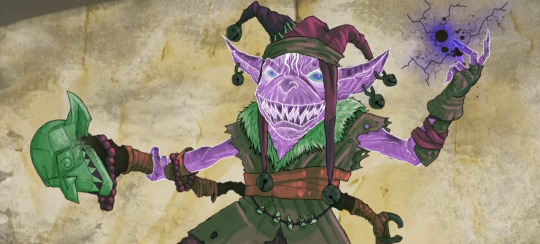
Checkout our new post over at https://lichlair.com/daily-monster-59-nilbog
Daily Monster #59: Nilbog

Welcome to Ranger week! For this very special week we’re going to be taking a look at three monsters at different CR levels that rely on range attacks and effects for combat. Today we start things easy with a CR 1 creature…

Nilbog
The basics
I’m very excited to cover today’s monster so let’s just get started with some numbers…
Nilbogs have matching STR and WIS of -1, which is to be expected of goblinoids. Their INT and CON is also not much better at only a +0, but this particular brand of goblin isn’t only moderately superior in DEX as is to be expected (+2), but also in CHA (+2).
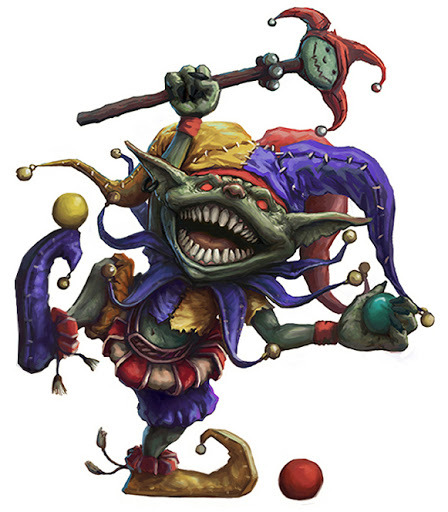
These creatures are pretty nimble with a +6 modifier to their Stealth and the ability to disengage or hide on a bonus action, but other than that they don’t really get much in the way of attributes. Today’s goblinoid can also speak both Common and Goblin and has Darkvision to a range of 60ft.
In terms of durability, well, it’s not much; we’re looking at an AC of 13 and only 2d6 worth of hit points with no resistances or vulnerabilities. That said, these small chaotic evil humanoids have other ways to go about this problem, as we will discuss in a second.
Nilbogs have the Innate Spellcasting feature that allows them to cast the following spells:
At will: mage hand, Tasha’s hideous laughter, vicious mockery
1/day: confusion
One of the two most peculiar traits for today’s monster is Nilbogism; an ability that makes it so that anyone trying to attack our monster will have to make a CHA save or succumb to the terrible fate of praising the Nilbog as their action instead.
While the Nilbog is able to use its Fool’s Scepter for close combat attacks, you’ll most likely end up using its Shortbow instead so you can take full advantage of the bonus action hide and the +6 Stealth bonus. That said, when the arty eventual does catch up to your Nilbog, Reversal of Fortune is bound to buy you a little more time…and groans from the rest of the table; using this reaction (we love reactions!) our goblin can not only completely avoid taking damage, but also heal in the process, which is great because the Nilbogism trait does state that these particular goblins cannot be healed in any other ways.
Far above most goblins, the Nilbog is a CR 1 creature.
The lore
What’s goblin spelled backwards? Yup, there it is.
Today’s creature has made a few rounds in popular media and films but tends to be more closely associated with goblins than our D&D version of it. When it comes to our favorite hobby, we can trace this creature back to 1st edition (1st Fiend Folio, to be more exact), which is still the place we get most of our lore from, since there hasn’t been other appearances until the most recent 5th edition version that appears on page 182 of Volo’s Guide.
From this original instance of the creature we learn that nothing is quite as it seems with Nilbogs; while to all intents and purposes they appear as any other goblin, there is a 0.001% chance that said goblin might be affected by a terrible affliction known as ‘Nilbogism’. You see, Nilbogs aren’t born, but rather made; the come to existence when a fragment of a trickster goblin god spirit decides to inhabit the recently downed body of a regular goblin. Once a goblin has been affected in such a way, he becomes a Nilbog.

While there is some study that has been done on the matter, no one knows much about this condition; even the trickster goblin god’s name is unknown so that it might remain safe from those who would see it undone. What we do know about this condition is that it seems to affect the possessed goblin in a contrary manner, for example, those who attempt to harm him will instead heal him, starving the creature result in it gaining weight instead, and healing will result in harm… it’s all a game of opposites. While this condition isn’t contagious per se, it does affect those around the Nilbog in strange ways; while succumbing to praising the Nilbog is common, some might even go as far as feeling compelled to surrender their treasure to the Nilbog.
While it is very strange to encounter more than one Nilbog at a time, it’s not unheard of for goblin tribes to appoint a jester amongst their ranks, as they know that many are fearful of coming across the real deal. Nilbogs can even be venerated as gods by some goblin communities, but this usually doesn’t last very long since the goblins will tend to grow tired of the strange aura exuded by the creature and decide to banish it instead.
Those unfortunate enough to cross paths with a Nilbog must always be cautious; it is said that the spirit of a Nilbog will continue to haunt travelers who mange to dispose of him as it continues to reincarnate in the bodies of other goblins around the adventurers.
The execution
Okay so, this monster is definitely the sort that you would want to keep as a recurring encounter, or at least that’s what I would do. Granted it will probably be more of a recurring joke than a recurring villain, but I’ll probably get some laughs and might even open some doors for interesting side quests. If you play your cards right with this one it could even be one of those memorable bits about campaigns we’re always talking about.

I think the best way to go about this and surprise your players is to have them encounter a decently sized group of goblins with nothing too suspicious about it. Let them cast their spells and lower their numbers until they eventually reach this guy at the back of the room; if they’re anything like my players, chances are that they will be very confused about the saving throw, but just make sure to play it off and keep the combat running. I’ll probably take a couple of rounds before the room is clear minutes the Nilbog, at which point your party will probably have made a few attempts on its life, even i they hit though, it’s unlikely that no real damage will be dealt, heck, I’ve even read stories of players who took turns whacking at this thing to see who would finally make it pass the saving throw.
In terms of combat I would definitely recommend you stock up on the most goblinesque insults you can muster and prepare for a lot of hysterical laughter. Once the Nilbog becomes the prime target, do make sure to try to keep this guy from getting too swarmed; remember you only have one reaction per round! You want to make sure the encounter lasts long enough for the party to figure out what’s going on. Make good use of that range attack!

If you enjoyed this article and would like to be updated whenever we post something new, don’t forget to follow us on our social media. If you have any interesting comments or funny anecdotes do leave us a message in our forums!
1 note
·
View note
Photo

Checkout our new post over at https://lichlair.com/daily-monster-58-assassin
Daily Monster #58: Assassin

Okay, look, I know everyone out there has had an edgelord character at one point or another, but hear me out: I just had to sift through hundreds of pictures for what looked to be the exact same hooded character over and over again. To be honest, I have no idea how artists sit through their 5th dark and broody character commissions. For the love of god, at least try to have some variation! And those of you out there planning on commissioning similar portraits, I hope you tip your artist reeeeaal good.
Assassin
The basics
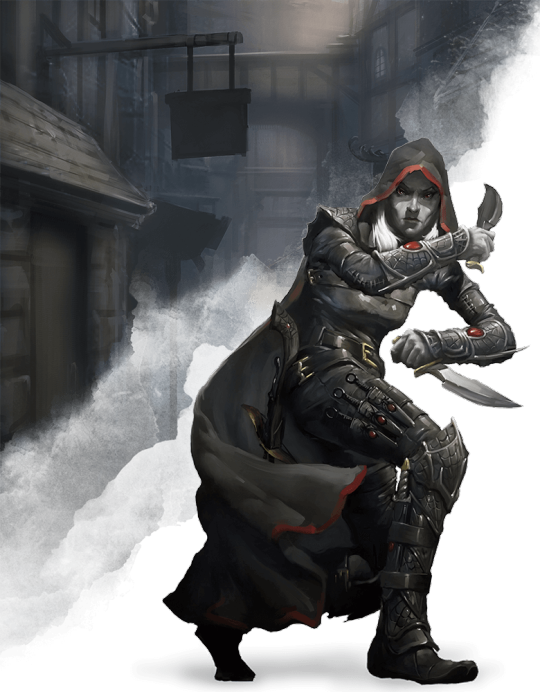
All things considered, assassins have pretty average stat blocks; we’re looking at matching +0 STR, WIS, and CHA, with their INT only being slightly better at a +1. Their best two stats are their +2 CON and +3 DEX. All in numbers that we could even expect from low level player characters.
These trained killers have proficiency in DEX (+6) and INT (+4) as well as Acrobatics (+6), Deception (+3), Perception (+3) and most notably Stealth (+9).
In terms of durability and resistance, today’s monster is resistant to poison, has an AC of 15 thanks to their studded leather armor, and a decently hefty hit point pool of 12d8+24.
To finish things off, assassins come in all races and colors (though technically limited to medium humanoids) and can benefit from their own particular racial features. They also have a passive perception of 13, and are able to speak two languages on top of their unique Thieves’ Cant.
Today’s monster also shares quite a few features with the playable rogue subclass of the same name. For starters, the Assassinate feature automatically give out monster advantage on rolls against creatures who haven’t acted yet and makes it so that any hit scored this way is also a critical. When running this creature we also get access to Evasion and Sneak Attack, both of which also work exactly as they do for Assassin Rogues.
For actions, we get the Multiattack feature that allows for two shortsword strikes, but also have the option to use a light crossbow attack instead. What sets these attacks apart from the usual is that on top of doing the regular piercing or slashing damage, there is also the possibility for a hefty amount of poison damage on a failed save DC15 CON save.
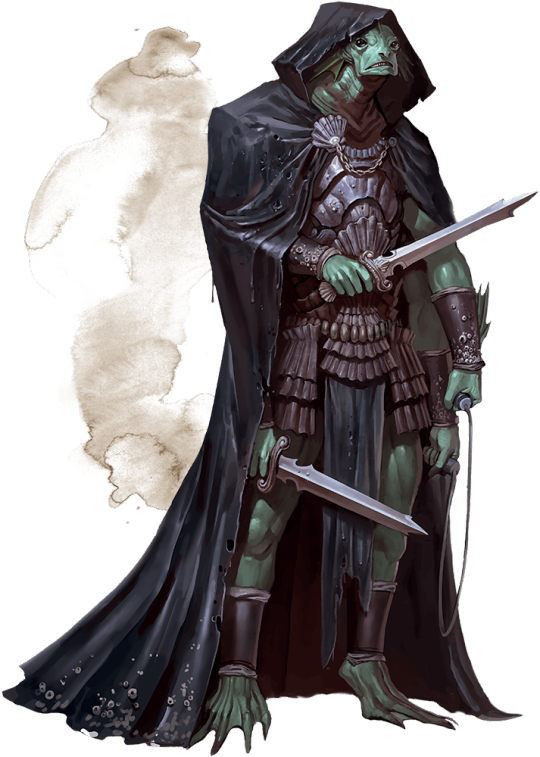
The lore
Well this one is easy… I don’t really think I have to explain what an assassin is to anyone; they’ve been an integral art of the game (and all media for that matter) for the longest of times.
You can find assassins pretty much everywhere in the world, from the most esteemed circles or royalty to the gutter streets of massive cities. Their specific skill set allows them to infiltrate any and all places required for them to take out their marks.
Whether hired by the wealthy or working undercover for any of many of the assassin guilds, once they strike it’s unlikely that why will leave any trace or witness to their crime.
In terms of specific lore, we can find some examples of assassin guilds throughout most of the official settings; from the notorious Zhentarim, and the Fire Knives, to the Jaezred Chaulssinin the Underdark.
The execution
The beauty about assassins everywhere is that it’s incredibly easy to set up an encounter with these guys as the baddies. Not only that, but they’re also ridiculously easy to run in combat while still packing quite a punch and have just the right proficiencies to get us to that anticipated “roll for initiative” call. Here are couple of ways in which you could set up your encounter:
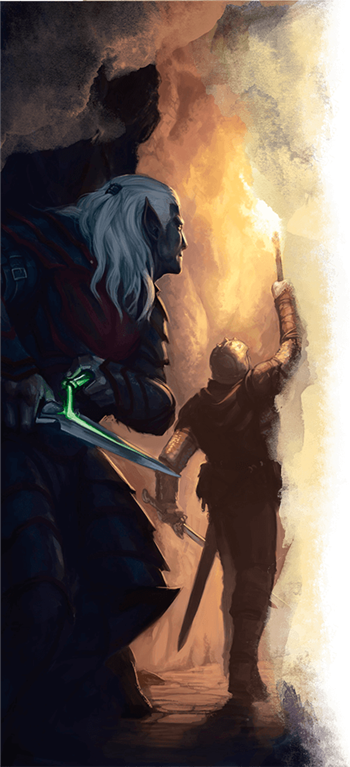
-Justice…kinda: Do you have an unruly party of so called “chaotic-neutral” adventurers that keep breaking the law and doing as they please throughout the land? Probably pissed quite a few powerful individual off too. Assassin, bounty hunter…you say tomato and I say tomato, really.
-Bodyguard duty: Are you a wealthy noble or magnate? Do you have vast amounts of cash and people who hate you for it who are now making plans to go after you? Why not hire a group of adventurers to guard tor most valuable asset (hint hint, it’s you!) and possibly unveil the people behind this nefarious plot?
-You done did it now: Let’s face it, our BBEG has better things to do than personally deal with these fools who keep ruining his plans, but he can’t exactly just let them keep doing that. Why not have them hire someone to take care of it?
In terms of how to play this out, it’s very important to keep in mind that, these are trained and proved professionals! Assassins know exactly what they’re doing and, more likely than not, have a ton of information on their marks. This is very important if their assignment turns out to be the party itself. Do keep in mind as well that, unless they’re part of some zealous movement and that is their reason for attacking, it’s unlikely for these guys to stick around much longer after things turn south for them; whatever payment they were offered is probably not worth their lives, after all.
The weekend in here and we have some secret secret reveals for you guys in the next couple of days! If you enjoyed this article and want to learn more about this surprise or simply get notified whenever we post a new article, do make sure to head over to our social media where you can click that follow button to get the latest news. We post new content every day of the week!
2 notes
·
View notes
Photo
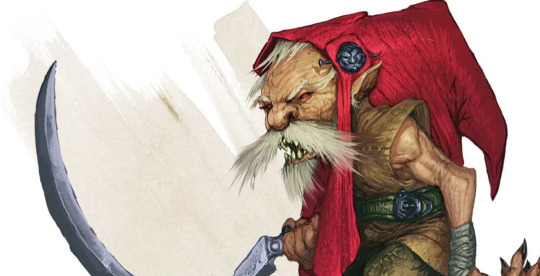
Checkout our new post over at https://lichlair.com/daily-monster-47-redcap
Daily Monster #47: Redcap

Look, I don’t know about you guys, but when I first heard of Dungeons and Dragons (specifically gnomes) I definitely pictured the garden variety. Although today’s monster definitely looks the part, I reckon you this is not the kind of creature you want to keep out on your lawn. Without any further ado, let’s take a look at…
Redcaps
The basics
Let’s get started with some numbers, shall we? Redcaps have a single negative stat, it being a -1 CHA, followed by a +0 INT and matching DEX and WIS of +1. The Redcap’s highest stat is their +4 STR, which seems all the more scary when you consider that they’re a size small.

These chaotic fey have an AC if 13 and a hit point pool 6d6+24. Unfortunately for them, their small size does mean that they have a restricted movement speed of only 25ft.
Redcaps get proficiency in Athletics (+6) and Perception (+3). They possess Darkvision to a range of up to 60ft and have a Passive Perception of 13. In terms of languages, today’s monster is able to communicate both in Common and in Sylvan.
Other than, well, their red cap, Redcaps can often be identified by the very peculiar sound of their metal boots against, well, pretty much anything. Which is why Redcaps have disadvantage on any stealth checks done while they’re moving. That said, their superb strength makes it so that they excel at any grapple despite their size; today’s monster counts as medium-sized for the purpose of grappling and has no disadvantage when using heavy weapons.
Now, okay, I’ve seen some ridiculous features and attack before, but can we talk about the Redcap’s Ironbound Pursue? They literally run up to an enemy and kick them in the chin so had that their target goes prone on a failed DEX save. Also nuts? The fact that these small fey get a three attack multiattack with their sickles.
The lore
While we’ve discussed quite a few myth inspired monsters, I believe this is the first time we’re covering one that comes from English mythology. The mythological counterpart of our monster is described pretty similarly to our book version; wrinkly old men with buck teeth, sharp claws, and the classic red hat. These beings are said to inhabit abandoned castle where they prey upon any unsuspecting travelers by dropping large rocks on them, after which the Redcap will soak its hat in its victim’s blood.

These creatures were introduced to Dungeons and Dragons all the way back in 3rd edition (3rd Monster Manual, specifically) and have since remained mostly the same minus a couple of changes (slingshot attacks were a thing, for example).
In terms of origin, today’s monsters comes from the Feywild or, well, the areas of the Feywild that border with the material plane, at least. More specifically though, places in which blood has been spilled in murderous rage. Once the land has been bloodied in this fashion, it is likely that crimson mushrooms will grow from it only to later sprout into a Redcap.
If there’s one thing you should know about these creatures before including them in your campaign it’s probably how truly evil and homicidal they are. In fact, unlike many monsters in the Dungeons and Dragons’ repertoire, it’s unlikely that they will stop attacking their target just because it has gone unconscious, which makes them all the more dangerous for our adventurers. To their benefit, this blood-lust is somewhat rooted in need, as Redcaps actually require their hats to be soaked in blood at least once every three days lest they cease to exist.
Although they are able to form communities of their own (other Feywild beings completely despise them) they often argue and fight constantly when doing so. The only way to keep a resemblance of peace is for Redcap elders to take over. These are older Recaps have grown wiser and more powerful thanks to their innate ability to absorb some element of their victims via blood. It’s also not completely unheard of for Hags and other despised fey beings to employ Redcaps in exchange for providing them with victims.
Another very interesting bit about these creatures is that some of them might actually be able to tell who it was that committed the heinous act that brought them into existence, often seeking out these individuals in an attempt to turn them into their next victims.
The execution
Is it bad that my first idea for an encounter against this monster was to have them be a punishment for murder hobo players? Look, all I’m saying is, that random NPC the rogue murdered outside of town over a new Thieves’ Tool set? That could be a small gaggle (heh) of Redcaps waiting to happen. All you have to do is give them the ability to know it was the Rogue and BAM! You got yourself a cool encounter that will, hopefully at least, teach a lesson to any murder hobo.

No, okay, but seriously, even if you don’t sick them on your players in this way, I think it’s important to think about some of the places where the party could encounter these cheesy lawn decorations. Technically speaking we could be looking at a wide range of places too; from fresh battle fields to raided towns.
For this article I think I would like to focus on the latter; it could be pretty simple to set it up as a recently raided town that is now basically covered in these crimson mushroom growths. It could be that the arty simply stumbles upon the site on a full moon, just as the Redcaps are about to rise, or that they’re sent in from a neighboring town that has recently had some trouble with these beings.
Another way you could go about it in a more ‘fetch’ sort of quest would be to have good aligned Fey require our adventurers to prove their good intentions by getting rid of a few of these and bring back proof in the form of teeth.
I don’t know about you guys but I’m definitely looking forward to pitting my players against some of these guys. If you want to discover other cool monsters to throw at your party do make sure to follow us on our social media so you can know when we have new articles out. We post new content every day of the week!
0 notes
Photo
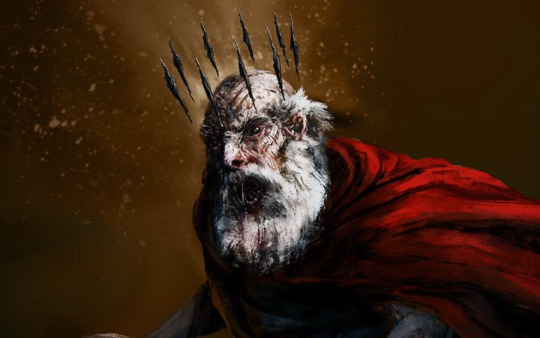
Checkout our new post over at https://lichlair.com/spell-archive-crown-of-madness
Spell Archive: Crown of Madness

Some of the spells in our archive have very specific ruling on how we are allowed to use them. Today’s entry happens to be one of those, but it is also the kind of spell that could make a big difference in combat.
Crown of Madness
2nd-level enchantment
Casting Time: 1 action
Range: 120 feet
Components: V, S
Duration: Concentration, up to 1 minute
One humanoid of your choice that you can see within range must succeed on a Wisdom saving throw or become charmed by you for the duration. While the target is charmed in this way, a twisted crown of jagged iron appears on its head, and a madness glows in its eyes.
The charmed target must use its action before moving on each of its turns to make a melee attack against a creature other than itself that you mentally choose. The target can act normally on its turn if you choose no creature or if none are within its reach.
On your subsequent turns, you must use your action to maintain control over the target, or the spell ends. Also, the target can make a Wisdom saving throw at the end of each of its turns. On a success, the spell ends
Spell Talk
A couple of interesting notes on this one. For starters, since Wisdom Saving Throws are one of the most common saves in the games, there’s a decent chance that your target might be equipped to deal with them depending on the type of monster. This is definitely something to keep in mind when picking up this spell.

Although 2nd level might sound like a bargain on this one, especially when compared with other similar spells like Dominate Person, you should definitely be aware of its one-minute duration. Chances are that trying to use this in an RP based situation won’t be as useful as casting Charm Person, for example.
As for the actual effect, I’d also be mindful of the fact that the creature must start its turn my taking the instructed attack before its movement or it’ll simply go ahead and do its own thing. That means that there’s a chance you won’t always be able to get the most out of this spell. That said, their being charmed and not able to target you in any way is still quite nice.
As long as you can hold concentration, and they don’t make the save at the end of their turn, of course.
Tips and Tricks
This is definitely one of those spells that you want to use only under the right circumstances. If you’re lucky and the situation calls for it, you might be able to take out the main threat out of an encounter and turn them to your side instead. This could be particularly beneficial when fighting a stronger monster surrounded by lower threat goons. Having the Hobgoblin turn on its goblin friends could definitely render the encounter as lot easier.
I would say a good rule of thumb is to only use this either in crowded spaces or when there’s plenty other targets near. We want to make sure that we won’t be wasting our turn concentrating on a spell that doesn’t do anything for us.
One last quick thing: the spell specifically requires for the attack to be of the melee kind. That means no casting this on other casters! Don’t do it!
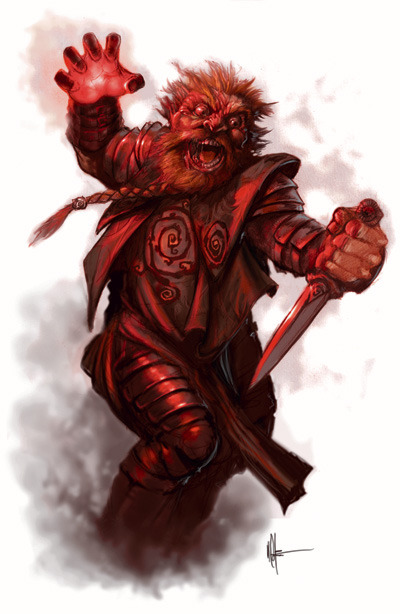
Reflavor
While it is technically a crown of madness, I don’t see why it couldn’t technically be reflavored as pretty much anything else. Interestingly enough, the official wording does describe the target as having glowing eyes, so you could very much lean into that as much as you want.
Another bit you could change up (or talk to your Dungeon Master about) is just how aware the creature is of their enchanted state. Are they conscious and fighting it the whole time? Or is it more of a primal urge that overcomes them? Maybe it’s a bit more subtle and they simply see you as a friend.
All these different things could make this spell unique to the caster.
And that’ll do it! Thank you guys so very much for reading through this article and supporting us. Feel free to check out our twitter and instagram for updates and come interact with us over there!
0 notes
Photo
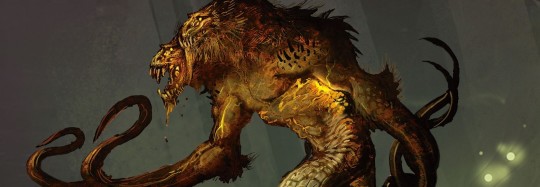
Checkout our new post over at https://lichlair.com/daily-monster-56-demogorgon
Daily Monster #56: Demogorgon

Today we’re talking about one of the most iconic monsters in Dungeons and Dragons. Not only that, but with the recent interest in this particular creature after Stranger things, I think it’s safe to say that at least a few newbies have found the hobby through it. Without further ado, let us discuss…
The Demogorgon
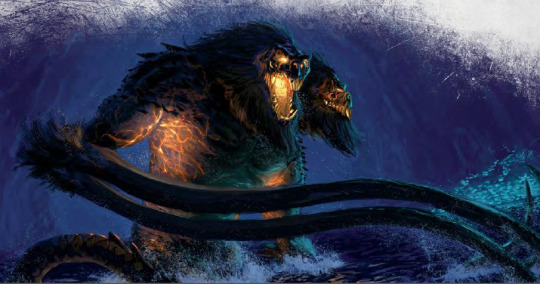
The basics
Alright, here we go, this one might just take a little longer than usual so let’s just get right into it.
Like our Tiamat article from a couple of months back, Demogorgon is definitely not the kind of monster you want to just throw at your party willy-nilly. Even just looking at the numbers for the stat block triggers my fight or flight instinct. We’re looking a solid +2 DEX for this monster’s lowest stat, granted, considering Demogorgon is a size Huge I would still think this is pretty great. Demogorgon’s WIS and INT are both more than acceptable at +3 and +5 respectively, but chances are that if you end up fighting this thing, you’ll want to watch out for its +7 CHA, +8, and +9 STR. That’s right, this thing has a 29 in strength.
Not only is this thing incredibly tough with an AC of 22 and a giant hit point pool of 28d12+224, but it also has some crazy saves and resistances! I’m talking about +10 DEX, +11 WIS, +15 CHA, and +16 CON to saving throws. Actual bananas… but even if you do manage to hit this thing, you still have to worry about overcoming Demogorgon’s resistance to Cold, Fire, and Lightning as well as its immunity to Poison and non-magical weapon attacks. And of you’re hopping to put this bad boy under some negative condition like charmed or frightened, you might want to think again because this chaotic demon has a handful of condition immunities as well. At this point sneaking your wait out might sound like the best choice but even that is unlikely considering Demogorgon’s Perception of +19, Truesight of up to 120ft range, and passive perception of 29.
Although communicating with this demon should be an easy task thanks to its telepathy of up to 120ft rage and its ability to speak all (and I do mean all) languages, I don’t recommend lying to the Prince of Demons; +11 to Insight might not sound like much after some of the other numbers we’ve discussed, but it’s still plenty.
Demogorgon gets an Innate Spellcasting ability that uses his CHA and has a crazy save DC 23. Using this feature he gains access to the following spells:
At will: detect magic, major image. 3/day each: dispel magic, fear, telekinesis. 1/day each: feeblemind, project image.
If you thought we were done listing all the ways in which today’s monster is a tough one to chew then you’re wrong; not only does he have a Magic Resistance that gives him advantage on saves, but thanks to its Two Heads, he also just gains advantage to save from pretty much every other condition that wasn’t in his list of resistances already.
Now that we’re done listing its features and attributes, it’s finally time to discuss some of the weapons at Demogorgon’s disposal. As a creature of legendary proportions Demogorgon has a multiattack and both Legendary resistances (3/day) and Legendary actions to compliment its array of attacks.
While under normal circumstances a Tentacle attack might not sound all that scary, getting hit by Demogorgon’s tentacles means having to make a save against hit point reductions. This basically means that it won’t matter how many clerics you have in your party because no healing can recover damage taken from these attacks.
Next we have Demogorgon’s infamous Gaze attack; any creature can choose to succeed on the save imposed at the cost of not being able to look at our demon until its next turn. Those who choose to hold his gaze must make a DC 23 CON save or suffer one of the following three effects:
Beguiling Gaze: on a failed save the target is stunned until the start of Demogorgon’s next turn or until the demon breaks eye contact.
Hypnotic Gaze: on a failed save the target is charmed until Demogorgon’s next turn, making it so that our demon can dictate their very action and move. Note that this cannot be use in conjunction with the Maddening Gaze legendary action.
Insanity Gaze: on a failed save the target suffers the effects of the Confusion spell, minus getting to make a saving throw, of course.
Today’s monster can take two legendary actions each round of combat. The first of our two options is a pretty simple Tail attack that does some pretty good damage but nothing else to boot. The second one, however, allows us to use Demogorgon’s Gaze an extra time per round as long as we only choose between Beguiling and Insanity.
All in all, this huge fiend definitely packs a punch. It’ no wonder he’s nicknamed the Prince of Demons. For those of you following along, today’s monster is considered a CR 26 creature of chaotic evil alignment.
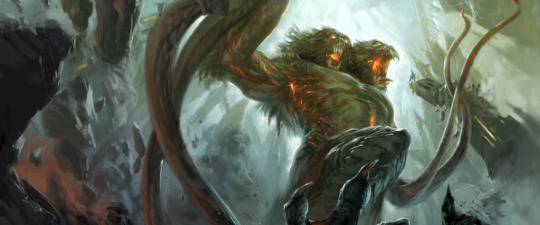
The lore
Historically speaking, although there is some debate about it, the word “Demogorgon” is mostly accepted to have been the product of miscopying ancient documents. While this initial misunderstanding of Greek equaled our Demon Lord to a primal god, Christian writers slowly turned the word to represent a demon in hell.
In terms of our favorite pastime, Demogorgon first appeared in the world of Dungeons and Dragons back in 1976 when it was introduced along with Orcus as part of the Eldritch Wizardry supplement. This is one of those monsters that have been a staple of the game for as long as there has been a game.
Today’s monster goes by many nicknames: Prince of Demons, Sibilant Beast, Master of the Spiraling Depths. Demogorgon reigns over the Gawping Maw deep within the Abyss (88th layer to be specific) where it has built itself a massive castle, Abysm, with two spiraling towers shaped like snakes, one for each head.
Speaking of heads, one of the most important features about the Demogorgon’s appearance is its two very large simian like heads, each of which has a name and a distinct personality. The first head, Aameul, is the more charismatic and deceptive of them, always making plans and trying to find ways to separate itself from its tin head, Hethradiah, who represents primal savagery and destruction rather than cunning. The rest of Demogorgon’s body can be described as a combination of scales and fur, with broad shoulders and two tentacles instead of hands.
Even though the word “scientist” might not be the first thing you think about when you see depictions of this creature, Demogorgon does in fact have a bit of a hobby in creating twisted creatures. As if being an 18ft tall mutated simian with two heads wasn’t enough, he can count on the creatures he has created such as retrievers, ettins, and death knights= as well as a steady supply of hezrou and other nefarious beings that he keeps under his command.
Although his cult isn’t as numerous or common as that of other demons and evil entities, the Sibilant Beast can count on the support beings like the kuo-toa, troglodytes, and even human beings. In fact, it’s not entirely uncommon for warlocks to seek pacts with Demogorgon.
There is a lot more I could cover for today’s monster, but for the sake of not having article end up being longer than the Wikipedia page, I believe I’ll leave it at that.
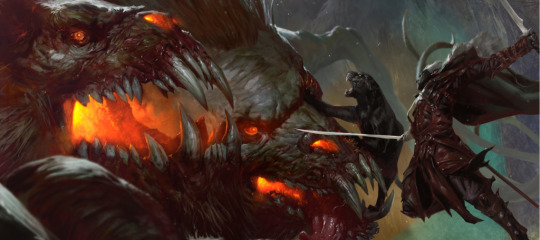
The execution
Oh boy, this is a big one. I definitely wouldn’t recommend throwing this at your players until they’re near max level or have some sort of godly support to back them up. This is the sort of BBEG you leave for the end of the campaign, that’s for sure.
So, okay, let’s get a couple of things situated before we being. The first of these is the fact that, unlike other evil entities, Demogorgon is unable to planeshift, which means that, if you really really want your party of adventurers to fight him you’ll have to make them go to him and, as fun as raiding Abysm sounds, I think I’d pass, personally.
The second thing we need to know is that while he cannot be summoned into the material plane, extremely powerful individuals who worship him might have the ability to summon an aspect of him, which is actually where we get our statblock from.
The way I see it those are our two real options on how to push for an encounter with this monster. I think a way to even the battle field a bit more and give your party a little more of a chance to survive this encounter would be to have Demogorgon be focused on a different goal while the party assaults him. Perhaps now that an aspect of him has been released into the Material Plane he’s on his way to destroy Waterdeep or something. This would leave your party with a couple of rounds to unleash their worst on our Demon Lord before it finally turns to deal with the annoying flies buzzing around it.
An interesting idea for this combat would be to have the first half of it focus on minimizing Demogorgon’s damage, and surviving the effects of his presence in the Material Plane before decides that getting rid of our pesky adventurers is the best call. On top of having stuff like flying giant boulders that are being tossed about by our Demon and the expected chaos of it barging into a city, you could also decide to spice things up by having a few of its faithful servants show up.
One of the things that I enjoy the most about combat both as a player and as a DM is to have choices. Would the players decide to deal with the chaos around the city and save innocent lives? Or would they focus on trying to dispatch our Demon Lord back into the Abyss?
Aaaand that’s it for today. If you enjoyed this article and want to see other similar content, don’t forget to visit our social media so we can let you know when we post new articles. We put up new content every day of the week!
1 note
·
View note
Photo

Checkout our new post over at https://lichlair.com/daily-monster-55-eblis
Daily Monster #55: Eblis

When you ask most people what sort of animals they grew up with, most of the time you’ll get the typical dog or cat response. Some of us were never quite as fortunate, however. Me? I had a parrot and, if there’s something I learned from that experience, it’s that all birds are evil, which is why I’m not surprised today we’re talking about the…
Eblis
The basics
Let’s get right into it with some numbers; all things considered, the Eblis has stats that aren’t too far from what some low level adventurers might start with. We’re looking at a DEX of +3 followed by matching +1s in CON, INT, and WIS. This alone already makes our monster smarter than a large portion of player characters. That’s without even mentioning that this smart bird (technically a monstrosity) has no negative stats, but rather average +0 STR and CHA. I don’t know about you guys but I’ve definitely rolled lower stats than these in the past.

As we will discuss in detail for later sections of this article, Eblises are neutral evil monstrosities of CR 1. They have a +4 to Perception checks as well as a passive perception of 14, which are both pretty high for their CR, especially with combined with their superior movement of 30ft and 40ft flying.
The Eblis’ intelligence is showcased both in the fact that they can speak two languages (Aquan and Common) and their Innate Spellcasting ability that allows them to cast the following spells:
1/day each: blur, hypnotic pattern, minor illusion.
Other than these spells, however, we don’t get much in the way of attacks; our only option being to multiattack using the Eblis’ Beak attack.
The lore
This particular Dungeons and Dragons monster can be traced back all the way to 1st edition, where it made an appearance in a 1983 module.
The Eblis is an oversized crane like bird that be uniquely found in the areas near Chult. In many ways it shares some traits with common birds but in others, such as its intelligence, it greatly differs.
Thanks to their high intelligence, these monstrosities are quick to build communities near riversides that work together to increase their communal pile of treasure. In fact, it could that, as a result of their extreme greed, the Eblis have turned towards an evil alignment. That said, offering treasure to these creatures is one of the few ways one might use to avoid their wrath and perhaps even gain their aid. On the other hand, It’s not unheard of for particularly spiteful Eblis to lure travelers into traps so that it can have easy picking of their belongings afterwards.

Because of their generally evil disposition, many Chult locals hold the belief that the Eblis are a form of reincarnation for evil humans who have committed heinous crimes.
In terms of combat, even though today’s creature can use its beak and claws as weapons, it greatly favors using its magic instead.
The execution

While running large powerful creatures is certainly fun, there’s just something very special about being able to run encounters that solely rely on intelligent baddies. Today’s creature in particular offers quite a few possibilities to create an encounter around them. Let’s take a look at some of them:
Stolen treasure: As mentioned in the lore section, these creatures have one particular trait that they share with dragons and that is their greed; from stealing valuables jewelry from the local noble family, to taking away a little girl’s favorite doll, there could be a long list of potentially valuable items for our party to have to recover from the Eblis. Unlike the other two ideas featured in this article, this particular method offers your players the possibility to use their sneaking skills. The great thing about this one is that the item in question could be just about anything you need it to be.
The retrieval: You know that scene in Jumanji where, just as our heroes are about to get their hands on the prize, a pelican swoops in and steal it away prompting a pretty comical chase scene? Yes, that’s exactly what I’m suggesting here. This idea is somewhat similar to the first, but rather than sneaking around, you might have the opportunity to call for some group checks.
The guide: What’s better than having an NPC show up to aid your players when they need it most? I’ll tell you what: having a trickster NPC show up when the party needs it the most only to give them into a trap so that they can steal the party’s treasure. I think out of all three set-ups I like this one the best, I think it would be pretty interesting to see how long it takes for the players to realize that their savior is in fact out to get them.
Aaaand that’s it for today. If you enjoyed this article and want to see other similar content, don’t forget to visit our social media so we can let you know when we post new articles. We put up new content every day of the week!
0 notes
Photo

Checkout our new post over at https://lichlair.com/4-more-official-alternate-rules-to-consider
4 MORE Official Alternate Rules to Consider
A couple of weeks ago we discussed 5 very interesting rules that you could possibly benefit from by adding them to your game; you can find that article over here. Today we are taking a look at 4 other official rules that are worth exploring.
Explosives
A campaign might include explosives from the Renaissance or the modern world (the latter are priceless), as presented in the Explosives table. Bomb: As an action, a character can light this bomb and throw it at a point up to 60 feet away. Each creature within 5 feet of that point must succeed on a DC 12 Dexterity saving throw or take 3d6 fire damage. Gunpowder: Gunpowder is chiefly used to propel a bullet out of the barrel of a pistol or rifle, or it is formed into a bomb. Gunpowder is sold in small wooden kegs and in water-resistant powder horns. Setting fire to a container full of gunpowder can cause it to explode, dealing fire damage to creatures within 10 feet of it (3d6 for a powder horn, 7d6 for a keg). A successful DC 12 Dexterity saving throw halves the damage. Setting fire to an ounce of gunpowder causes it to flare for 1 round, shedding bright light in a 30-foot radius and dim light for an additional 30 feet. Dynamite: As an action, a creature can light a stick of dynamite and throw it at a point up to 60 feet away. Each creature within 5 feet of that point must make a DC 12 Dexterity saving throw, taking 3d6 bludgeoning damage on a failed save, or half as much damage on a successful one. A character can bind sticks of dynamite together so they explode at the same time. Each additional stick increases the damage by 1d6 (to a maximum of 10d6) and the burst radius by 5 feet (to a maximum of 20 feet). Dynamite can be rigged with a longer fuse to explode after a set amount of time, usually 1 to 6 rounds. Roll initiative for the dynamite. After the set number of rounds goes by, the dynamite explodes on that initiative. Grenades: As an action, a character can throw a grenade at a point up to 60 feet away. With a grenade launcher, the character can propel the grenade up to 120 feet away. Each creature within 20 feet of an exploding fragmentation grenade must make a DC 15 Dexterity saving throw, taking 5d6 piercing damage on a failed save, or half as much damage on a successful one. One round after a smoke grenade lands, it emits a cloud of smoke that creates a heavily obscured area in a 20-foot radius. A moderate wind (at least 10 miles per hour) disperses the smoke in 4 rounds; a strong wind (20 or more miles per hour) disperses it in 1 round.Source: DMG, page 267
Okay, hear me out, you don’t need to have all the different types of explosives, and it definitely doesn’t need to be a worldwide thing; maybe it’s only the Dwarves who make use of explosives for their mining, or a specific civilization that utilizes them. The key here is introducing the explosives as you would any new item, describe what they look like without directly spoiling what they are and I guarantee once recognition sets in for your players, you’ll be glad you added them in.
Fear and Horror
The rules for fear and horror can help you sustain an atmosphere of dread in a dark fantasy campaign. Fear: When adventurers confront threats they have no hope of overcoming, you can call for them to make a Wisdom saving throw. Set the DC according to the circumstances. A character who fails the save becomes frightened for 1 minute. The character can repeat the saving throw at the end of each of his or her turns, ending the effect on the character on a successful save. Horror: Horror involves more than simple fright. It entails revulsion and anguish. Often it arises when adventurer see something completely contrary to the common understanding of what can and should occur in the world, or upon the realization of a dreadful truth. In such a situation, you can call on characters to make a Charisma saving throw to resist the horror. Set the DC based on the magnitude of the horrific circumstances. On a failed save, a character gains a short-term or long-term form of madness that you choose or determine randomly, as detailed in chapter 8, “Running the Game.” Source: DMG, page 266
This one is one of those rules that Dungeon Masters en up imposing without really noticing they are. It’s also very reminiscent of other TTRPGs such as Call of Cthulhu. When set up properly, I think this rule could go a long way toward setting the atmosphere for a tense moment.
Proficiency Dice
This optional rule replaces a character’s proficiency bonus with a proficiency die, adding more randomness to the game and making proficiency a less reliable indicator of mastery. Instead of adding a proficiency bonus to an ability check, an attack roll, or saving throw, the character’s player rolls a die. The Proficiency Die table shows which die or dice to roll, as determined by the character’s level. Whenever a feature, such as the rogue’s Expertise, lets a character double his or her proficiency bonus, the player rolls the character’s proficiency die twice instead of once. This option is intended for player characters and nonplayer characters who have levels, as opposed to monsters who don’t. Source: DMG, page 263
Once again, this optional rule is reminiscent of other systems. I definitely enjoy the idea of making proficiency a bit more randomized, but my one concern is the additional dice involved. I feel like players, especially newer players, might struggle with this a little.
Planar Effects
When adventurers travel to other planes of existence, they undertake a legendary journey that might force them to face supernatural guardians and undergo various ordeals. You can choose to add effects to any or all of the planes, to better represent their uniqueness.Source: DMG, page 50
Who doesn’t like plane hopping? By adding this rule you’ll also be adding a little extra something to the experience. Not only that but this ruling also helps to accentuate the different flavors of the various planes.
If you enjoyed this article and don’t want to miss out on any of our future ones, make sure follow us on our social media to be informed whenever we post new articles. We write new content every day!
0 notes
Photo

Checkout our new post over at https://lichlair.com/daily-monster-53-piercer
Daily Monster #53: Piercer

Today we’re going to talk about the Roper’s lesser cousin, and I gotta say I’m a bit disappointed we rolled for this one before talking about Ropers. That said, I’m pretty interested to learn more about these strange creatures. Without any further ado…
The Piercer
The basics
…a-are you kidding me? Who decided to make this a monster?! I—
Fine. I guess we might as well take a look at the Piercer’s stats since I already went through the trouble of setting up the template for this article. I suppose it’s slightly better than that one time I had to write about horses. Only by a little though, only by a little.
You know, for a CR 1/2 creature, Piercers have acceptable stats, specially considering how bad the rest of their block is. We;re looking at a +3 CON and +1 DEX followed by an average STR of 10. The rest if the numbers are all in the negatives with a -2 to WIS, -4 to CHA, and last but most impressive, an INT of -5.
In terms of combat durability, today’s monster has an AC of 15 and hit point pool of about 3d8+9 hit points.
For all the gents reading this, you might want to skip this next bit because I just have to make a point of how dumb these creatures are. You know what Piercers are? They’re goddamned tampons. The goddamned tampons of Dungeons and Dragon and here’s why: you can only use them once and then that’s it.
Sure, they get a +5 to Stealth as well as the False Appearance feature, but everything else is garbage; those 30ft of Blindsight and 60ft of Darkvision might look really nice at first glance but this monstrosity only has a passive perception of 8, which makes it kind of moot.
Also completely redundant? Their Spider Climb feature. Look, this is probably one of the coolest abilities to have in combat and the fact that it’s rendered completely useless by the Piercer’s 5ft of movement speed irks me beyond belief. There’s just no way this monster is making it back onto the ceiling after using its Drop attack, which is already terrible as is.
The Lore
Also of note? They have one of the dumbest minis.
The first thing you gotta know about these creatures if you don’t already, is that they are very closely tied with Ropers; in fact, they are Ropers, just, you know, in larval form
In terms of how exactly this creature came to be, well, that’s a bit more complicated, especially because there is actually another creature in Dungeons and Dragons that has a similar purpose and appearance, although that one is considered a Mollusk rather than a monstrosity. If we go by numbers though, we can trace this creature back to 1975 when it appeared in a couple of magazines of note.
Like their fully grown versions, they stick to the underground; more specifically the ceilings of dark caves. Unlike their adult counterparts, however, Piercers are a lot smaller.
Something important to keep in mind about this creature is that it very much works in large groups. Although you might only find them in groups of ten or so in higher elevation caves, it’s not unheard of to find groups of them in the three digits the deeper you go into the underground.
The execution
Okay so, alright; I’ve calmed down a little after working through that last section. If we disregard the fact that they look like the stuff I clean out of my cat’s litter box, then there might be some merit to these creatures.

I have to admit that my first thought after having read their statblock was pretty much to wonder why you would even use these creatures when you could just have some regular old stalactites fall on your party, maybe even some sort of trap. But here’s where Piercers have just a sliiight advantage: unlike traps, they won’t be picked up by Detect Magic nor will they be identifiable thanks to their False Appearance. I guess this would be kind of a fun thing to pull on the rogue that keeps acting to look for traps for each and every one of the corridors.
I also know that these things are supposed to go hand in hand with Ropers, which, of course makes them all that much deadlier; thing is, for these articles I usually try to set up an encounter in which our Daily Monster is the star of the show, but that’s a bit difficult to do with the Piercer.
Sure, you could always do the thing where the party enters a large cavern or some sort of really long corridor that is completely cluttered with these things, but where’s the fun in that?
Maybe the best way to approach this one is to run it a little more uh, how should I say this, intentionally. If the lore is anything to go by, we know that these creatures are fairly numerous and that they can be use as food preservatives. Why not have your party run an errand in which they have to collect a certain number of These things? I think it would be fairly amusing to see how they would go about it; will the party members stand under the Piercers intentionally to have them drop? Or perhaps they use illusion magic to fool them into doing so instead. Personally, I think we should just Fireball them.
Aaaand that’s it for today. If you enjoyed this article and want to see other similar content, don’t forget to visit our social media so we can let you know when we post new articles. We put up new content every day of the week!
1 note
·
View note
Photo

Checkout our new post over at https://lichlair.com/spell-archive-bones-of-the-earth
Spell Archive: Bones of the Earth

Not all of the books found in the Spell Archive are well-worn. Today we talk about a bit of an obscure spell that I must admit I myself hadn’t heard of before. I believe this also our very first druids only entry and I’m very excited to find out what sort of potential it holds.
Bones of the Earth
6th-level transmutation
Casting Time: 1 action
Range: 120 feet
Components: V, S
Duration: Instantaneous
You cause up to six pillars of stone to burst from places on the ground that you can see within range. Each pillar is a cylinder that has a diameter of 5 feet and a height of up to 30 feet. The ground where a pillar appears must be wide enough for its diameter, and you can target the ground under a creature if that creature is Medium or smaller. Each pillar has AC 5 and 30 hit points. When reduced to 0 hit points, a pillar crumbles into rubble, which creates an area of difficult terrain with a 10-foot radius that lasts until the rubble is cleared. Each 5-foot-diameter portion of the area requires at least 1 minute to clear by hand.If a pillar is created under a creature, that creature must succeed on a Dexterity saving throw or be lifted by the pillar. A creature can choose to fail the save.If a pillar is prevented from reaching its full height because of a ceiling or other obstacle, a creature on the pillar takes 6d6 bludgeoning damage and is restrained, pinched between the pillar and the obstacle. The restrained creature can use an action to make a Strength or Dexterity check (the creature’s choice) against the spell’s save DC. On a success, the creature is no longer restrained and must either move off the pillar or fall off it.
At Higher Levels. When you cast this spell using a spell slot of 7th level or higher, you can create two additional pillars for each slot level above 6th.

Spell Talk
Alright, firs off, I’m kind of surprised there’s not a lot to be found on this spell online. It looks to me like the kind of spell that could turn out to be a multi purpose tool for creative players. The fact that creatures can choose to fail the save to be affected by it makes it obvious that the intent of this spell isn’t simply to damage enemies.
But it isn’t just the creative aspect of the spell that has potential; this transmutation spell already comes with a multitude of useful effects that can be exploited in various circumstances (which we will cover in more detail for our tips and tricks section), but as it is, restraining and causing difficult terrain are nice as is, especially if you’re playing a druid or a ranger.
As much as I like the flavor and possibilities that come with this spell, I do have two minor gripes with it, the first being that, despite the aforementioned possibilities, 6th level just seems a bit too costly for what we get in return, I think the magic number for this one would be around 4th level instead. My second issue with this spell (which only furthers the first) is that 30ft just won’t do the trick on many occasions, it would have been interesting to have the spell function similarly to spells like Wall of Fire where there is a max limit but the construction of the spell is up to you; I feel like this would have worked out nicely with creating different numbers of pillars as well.
Tips and Tricks
As I mentioned previously, the great thing about this spell isthat it can very much be used creatively. Yes, sure, you can also use it to incapacitate your enemies in what’s probably one of the coolest fashions, but there’s a lot more to it than that.
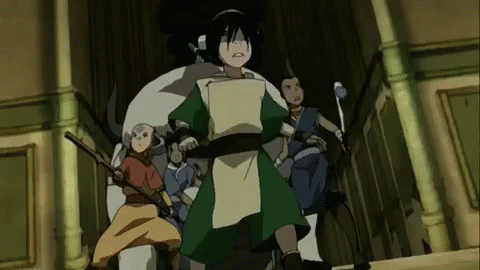
Let’s face it, no one was as cool as Toph.
You could very much use this spell as an easy way to to get over obstacles or even propel yourself (or your friends) to where you want to be like in this gif:

Or if you’re looking for something a little more combat/strategy oriented you could use them as a way to modify combat areas to your advantage; I’m sure the party rogue will be grateful for all the new places they can hide to get their sneak on.
Want to give the casters/ ranger a bird’s eye view while also keeping them away from harm? This could pair very well with feather falling, and is sure to have your enemies waste at least one of their turns to get rid of it.
Reflavors
An interesting idea you could play with is checking to see if your Dungeon Master would allow you to reskin this as other elements; columns of water or pressurized air could make this the perfect spell for druid Genasi.
All in all, although technically not a reflavor, if you’ve ever wanted to play an Earthbender from AtlA, this spell is most definitely a must.
And that’ll do it! Thank you guys so very much for reading through this article and supporting us. Feel free to check out our twitter and instagram for updates and come interact with us over there!
1 note
·
View note
Photo
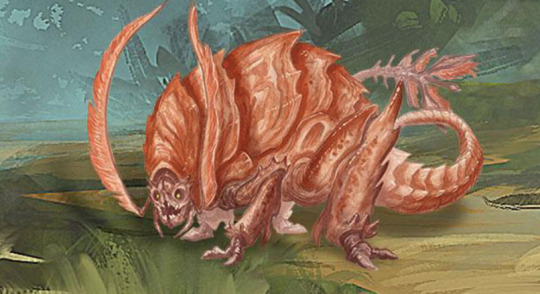
Checkout our new post over at https://lichlair.com/daily-monster-52
Daily Monster #52:
Today we’re going to be taking a look at another one of those monsters that have been a part of the world of Dungeons and Dragons for a very long like. Tired of never hitting the fighter and the cleric? Why not try the…
Rust Monster
The basics
As far as stats go, these creatures are fairly straight forward. Rust Monsters have a very average stat array with +1s to most stats except for CHA and INT, which are a -2 and -4 respectively.
Likewise, they don’t really get much in the way of languages or saves, or anything like that. The only perk they enjoy is having a Darkvision of 60ft, which, I suppose is better than what some playable races get.
“I-I don’t wanna talk about it.”
These creatures are considered medium monstrosities and are usually unaligned. They have an AC of 14, a slightly above average movement speed of 40ft, and a hit point pool of 5d8+5.
What makes these creatures interesting is their affinity (or lack thereof) with metals. In fact, the Rust Monster is able to smell the location of any metals within 30ft of it.
Yeah, even that thing that the rogue stole from that town two sessions ago.
I imagine this next feature doesn’t come as a surprise either but, thanks to their Rust Metal feature, any non-magical weapon that manages to land a hit on this creature suffers permanent damage to the point where it can end up being destroyed. Likewise, our Rust Monster can take its action to use its Antennae to corrode metal objects within 5ft on a failed DEX save. Unfortunately for the heavy armored adventurers, this definitely includes armor and shields, which, similarly to weapons, take permanent damage on a fail save and can also be completely destroyed.
Other than making the righteous Paladin quake in their boots at the prospect of losing their favorite sword these creatures don’t get much else; their only output for actual damage is a single Bite attack that does as much damage as you’d expect for a CR 1/2 creature.
The lore
In the world of Dungeons and Dragons, a big majority of the monsters that we stumble upon as in fact versions of creatures detailed in the various mythologies of the world. The Rust Monster, however, isn’t one of them. Although it has been a part of the game for all of its iterations, we can at most speculate that they were the result of taking inspiration from a box of children’s toys.
But what do we know for certain about these creatures? Well, for starters they’re giant bug like monsters roughly about the size of a pony, with chitinous armor and two antennae that grow from the sides of their heads. These are the most important feature of a Rust Monster and what allows that very particular ability to turn the strongest of metals into a pile of mush. It’s not only the antennae that have a rusting property; it’s a very specific combination of bacteria in their blood, which is also the reason why cutting into these things doesn’t bode well for metal weapons.
Rust Monsters are, for the most part, extremely docile creatures that will not attack anyone who isn’t carrying metal. In fact, even if you are carrying metal, it is likely that they would simply ignore you and go straight for the metallic item instead.
Since these creatures prefer to inhabit underground areas, it’s not unlikely to come across them while in a mine shaft. This is one of the reasons why dwarves and other mining races have developed ingenious traps and systems to maintain the Rust Monster population on the lower side of things.
Thanks to their mostly non-aggressive natures, it’s not unheard of for individuals to use them in the disposal of old metal items and similar tasks. Races like the Kobold have even learned how to use them as mounts to ride into battle and, unfortunately for the Rust Monster, their antennae are crucial ingredients in the making of various magical items.
The execution
There’s a few ways to go about this one, the first is to simply have the party be tasked with harvesting a number of antennae for the creation of a magical item, whether that be the cost of creating an item of their choosing or simply a quest from an NPC that’s up to you. I’ve done this for my Ghost of Saltmarsh campaign on several occasions and it always turns out pretty well.
Another alternative is to have the group learn about (or run into) a convoy of miners that urgently need the party’s assistance in dealing with this creature. Hells, we even have a module with the word “mine” in it so this encounter should be easy enough to set up. Just for the heck of it, we could even have this be a rescue mission; maybe one of the least experienced miners found themselves terrified at the sight of these creatures, panickedly ran, and climbed up a pillar or something.
This is exactly what miners look like where I’m from.
Depending on how prepared you want your players to be for this one, they could have little information about the “strange bug creatures” that are harassing the miners. Remember that, if the wizard rolls a good history check to recall information about these creatures or if the miners simply supplies the party with information, it is likely that this encounter wouldn’t turn to combat at all, but rather become a game of persuading the trapped individual into calming down and relinquishing their metal tools.
In terms of combat, it’s important to remember that these creatures won’t actually use their bite attacks unless cornered and extremely hurt and that they will simply try to get at the biggest source of metal that they can find. Rust Monsters might not be exactly a lethal encounter, but they are certain to test your players’ mettle.
If you enjoyed this article and don’t hate me for writing that pun, do make sure to head over to our social media so we can let you know when we post new articles. We have new content for every day of the week and some exciting news to come!
3 notes
·
View notes
Photo
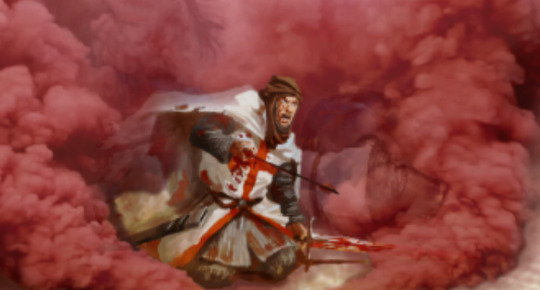
Checkout our new post over at https://lichlair.com/daily-monster-51-vampiric-mist
Daily Monster #51: Vampiric Mist
Our very first vampire!… at least technically, but considering how we had to cover an actual household item just a couple of entries back, I’ll definitely take it. Let’s see what this monster has in stores for us…
Vampiric Mist
The basics
All things considered, not bad stats for a CR 3 creature. We’re looking at matching +3 DEX and CON followed by a WIS of +1. Unfortunately, if you were looking to make use of any other stats why running this monster, you might not be able to do so considering their STR, INT, and CHA are all at a nice -2.
But let’s have a look at the Vampiric Mist’s durability. After all, that’s a pretty decent CON score, right? Well, not quite… this medium undead only has a hit point pool of 4d8+12 and an AC of 13. Thankfully though, their list of resistances and immunities does somewhat help with this since it does include resistances to Acid, Cold Lightning, Necrotic, Thunder, and non-magical weapon damages. You might have noticed that Fire isn’t part of the list, unfortunately, but the mist does have a single immunity to poison as well as several condition immunities.
As a last couple of points, the mist cannot speak nor communicate in any languages, has a passive perception of 11, and a hovering speed of 30ft.
Despite its low passive perception, today’s monster has a very specific feature called Life Sense which basically translates to knowing the location of any living creature within 60ft of it. Emphasis on living though, keep that bit in mind.
Like vampires in most movies, the mist also requires an invitation into a home before it is able to enter it as explained in their Forbiddance feature. Once that’s done, however, the smallest crack in a window frame will be enough for it to squeeze through thanks to its Misty Form. This ability also allows the mist to share a space with other creatures.
Although Radiant damage isn’t listed under vulnerabilities, the mist does suffer from Sunlight Hypersensitivity, which not only imposes disadvantage on rolls while in the sun, but also drains 10 hit points per turn.
The only attack available to this monster is its Life Drain. On a failed CON save, any creature that isn’t a construct or already undead takes 2d6+3 necrotic damage while our monster heals for the same amount. Once this damage is taken, the reduction lasts until the target takes a long rest. As with most similar abilities, if a creature is reduced to 0 hit points in this way, it immediately dies.
The lore
The Vampiric Mist has been a part of the world of Dungeons and Dragons ever since 1st edition, with only 4th edition omitting it from its rooster. To talk about today’s monster we need to take a quick look at what happens when a vampire is defeated; that is, once a vampire has taken enough damage or has been forced into the light for prolonged amounts of time, their body will simply turn into a fine mist that will (most likely) attempt to flee so that it can return to the vampire’s coffin, where it will promptly reform into a vampire again. Today’s monster, however, is what happens when a vampire is unable to return to its’ coffin upon death. Whether that be because our valiant adventurers have destroyed it or because something doesn’t permit them to return.
While most examples of vampires in media, Dungeons and Dragons included, present vampires as cunning and intelligent individuals that usually pose a big threat for the heroes, once these creatures have been reduced to their mist form they lose all of these qualities that make them so especial. Instead, they are purely driven by an insatiable hunger for blood.
Most common folk see no difference in the threat posed by a full vampire and a Vampiric Mist, however; to them, they are both just as deathly. And while most agree that these beings are what remains of vampires, there are other superstitious individuals who claim that these are the souls of innocents that had been turn into vampires or even simply evil Air Elementals that have been cast out of the Elemental Plane of Air.
Like sharks, it is said that these undead creatures can smell the scent of blood for miles and will be drawn to it like moths to a flame. While most Vampiric Mists choose to inhabit swamps and the like, the smell of blood is enough to have them relocate to more inhabited areas.
The execution
Look, call me basic, but I really love vampires and when I rolled for this one I just went ‘!!!’. The great news about this is that I already know exactly how I would set up an encounter with this creature. That said, I would probably choose to tweak a couple of things depending on the party’s level (stay tuned to the end of this section to find out which bits I’d change), but for now, let’s set the mood:
Exhausted from a day of hard travel across desolate swamps, the party spots what appears to be a small village in the distance. With the sunset behind them, they approach carefully, but begin to notice signs that something isn’t right; all lights are off, and the small streets are completely empty. Upon entering the town, it becomes clear that all townsfolk have shut themselves inside their homes, the sounds of moving furniture against the door and hushing tones from within the buildings.
As the party wanders the streets trying to figure out what’s going on, a door cracks open just wide enough for a single eye to be shown. A frazzled looking woman urges the party to come in before ‘it’ arrives. Reluctant, the group of adventures accept the invitation and follow her into the small home, only to watch from the window as a red mist begins to fill empty streets. Whilst watching, our adventurers question their hostess and learn that a vampire has been plaguing their village for the past few months. It comes every week and searches the whole village as if looking for something, until it eventually finds a victim to suck dry. Just as the woman finishes her explanation, a single shrill scream pieces the tense silence.
I think this could be a pretty sweet encounter to run for your players. Depending on how RP inclined they are, the investigation portion of it could be really cool. Perhaps they discover that the town was build over what used to be the vampire’s crypt and that now, unable to enter it without permission, the Vampiric Mist lurks in the area feeding off of the villagers.
Alternatively, what if your adventurers were to instead find the mist prowling an old cemetery not too far from town? Maybe they investigate the area and find a particularly eerie crypt that has been sealed with divine wards and keeps the Vampiric Mist away from its coffin. If the players were to fall for the temptation and dispel the seals, they might even end up fighting a full on vampire.
In terms of adjustments you might want to consider, I personally think a medium-sized mist just isn’t creepy enough; instead, I would either make it so that there’re several mists (maybe it’s a whole family of vampires!) or upsize the mist so that it becomes that much threatening. On a similar note, depending on the players’ levels, I would also consider making it so that the Life Drain save applies to any number of creatures within its space rather than a single creature.
As always, thank you very much for taking the time to read about my hardcore love of vampires. If you enjoyed this article and would like to be notified whenever we post a new one, do make sure to head over to our social media where you can click that follow button, so we can let you know when we post new stuff. We have new articles every day of the week!
0 notes
Photo

Checkout our new post over at https://lichlair.com/daily-monster-50-night-hag
Daily Monster #50: Night Hag
Woah! We reached 50 already? Time sure goes fast. For those of you who have been reading from the beginning, thank you so much! If you’re joining us just now, welcome to Daily Monster! Today we have an extra especial pick for our monster…
The Night Hag
The basics
My first thought when looking at the Night Hag stats was “Hey, that’s not too bad, those look a little bit like player stats,” which all things considered it’s pretty good for a CR 5 creature.
We’re looking at a +4 STR, matching INT, CON, and CHA of +3, and +2s in DEX and WIS as the hag’s lowest stats. All around very solid with no negative or flat bonuses.
This medium-sized fiend has an AC of 17 as well as a pretty meaty hit point pool of 15d8+45 to ensure that combat will last an adequate amount of time.
Night Hags are proficient in a number of skills including Deception, Insight, Perception, and Stealth. All things that not only make this a formidable opponent for your players, but an interesting one in social situations.
In terms of resistances and immunities, this brand of hag is immune to being charmed and has resistances to Cold, Fire, and damage from weapons that haven’t been Silvered.
On top of speaking a few interesting languages like Abyssal, Internal, and Primordial, the Night Hag also has 120ft of Darkvision and a Passive Perception of 16.
This monster has both the Magic Resistance feature and the Innate Spellcasting feature, which allows them to cast the following spells without material components with CHA as their spellcasting modifier:
At will: Detect Magic, Magic Missile.
2/day each: Plane Shift (self only), Ray of Enfeeblement, Sleep.
Technically speaking, other than ray of enfeeblement and magic missile, your other only attack option when running these monsters will be their Claw attack.
That said, we do have an array of interesting abilities including Change Shape and Etherealness, where the first allows our creature to Polymorph into a humanoid, and the second let’s us step in and out of the Ethereal Plane as long as she has a Heartstone (we’ll talk about that one in a bit).
Last but not least, once per day Night Hags get access to an ability called Nightmare Haunting. Using this ability they can such a creature’s life force trough their dreams as they force terrible nightmares onto their sleeping victims. Since the Hag is technically in the Ethereal Plane as she does this, other creatures won’t even know what’s happening to their unfortunate friend. If the target is reduced to 0 hit points by this ability, it immediately dies and their soul gets trapped by the Hag.
The lore
This is where things get interesting. While I usually like to discuss the origin of creatures, I’m sure I don’t need a lot of introduction for this one; anyone who hears the word “hag” is bound to picture very similar images. That said, while we’ve previously discussed the Bheur Hag in older articles, today’s hag is very much especial in her own way.
As I’ve mentioned before, all hags originate from the Feywild, where they were kicked out of due to their strange mannerisms and dark rituals, which landed them in Hades (their domain plane) and the reason why they are no longer considered fey creatures but rather fiends.
While most hags choose to remain in the plane of Hades and simply choose to profit from the Blood Wars by selling souls to both demons and devils, some of them choose to make their lairs in the Material Plane. Night Hags in particular usually prefer dense forests or swamps where their mere presence slowly corrupts the area.
Night Hags usually have dual goals, the first, of course, being to simply further their power and magical abilities while the second is to find even more valuable souls that they can corrupt and sell to the highest bidder. As explained in their Nightmare Haunting skills, once a creature dies in this way, the hag is able to collect it using a specially crafted item called a soul bag. This item, together with the hag’s Heartstone, are a hag’s most precious possessions; while she is able to recreate them if needed, it is both taxing and expensive to do so, which is why they will go to great lengths to recover the original instead.
Another detail that sets Night Hags apart from their other hag counterparts is the fact that they absolutely hate the idea of forming covens with other kinds of hags, what’s more, even the idea of forming a coven with other Night Hags is rather unappealing to them.
There are two ways in which a new Night Hag can be born. The first one is simple enough; the hag can choose to take the form of a humanoid via her Change Shape ability and go at it the old fashion way OR she can instead decide to steal a young child from their home, eat them, and then give birth. In both scenarios the child appears completely normal to the point where Night Hags will often let the child return to their families until it is ready to go through the necessary rituals at age 13. If the child goes through the process, she becomes and hag. If, however, the necessary rituals never take place, the child grows to be a normal human, though this does make them perfect candidates for becoming sorcerers.
The execution
I have to admit that I really, really like the flavor and lore for this monster. In fact, the more I look at their stats and abilities, the more I realize that it might just be a better idea to use this monster as an encounter outside of combat. I have two ideas of how to go about this:
My first idea is to lure the hag towards our unsuspecting adventurers by handing them a very, very especial item: soul bag. This could be something that they loot or get their hands on from some sort of unlucky merchant who happen to come across this item. It could be that they’re even haunted by it and try to get our adventurers involved by swindling them into taking the item.
The other possible set up that comes to mind is to use a marked child for the encounter. Perhaps she has been haunted by nightmares and her desperate parents contract our adventurers into protecting her and keeping the Night Hag away until the time passes for her to be turned, and she’s safe from the hag.
Depending on your players’ levels, you could even have the Night Hag send other lesser creatures into the village to try to steal the child. Once our players thwart those efforts, it’s time for our big bad to show up. With some backup of course.
As always, thank you for reading! Fifty down, 1650ish more to go! If you enjoyed this article make sure to check out our social media so we can let you know when there’s a new article. We post new content every day of the week!
0 notes
Photo

Checkout our new post over at https://lichlair.com/5-official-alternate-rules-to-better-your-game
5 Official Alternate Rules to Better your Game
Let’s start of this article by reminding ourselves that Dungeons and Dragons is one of the few games that places a lot of emphasis on using our imaginations. As such, pretty much everyone behind our favorite game has always made a point of saying that any and all rules found in the official books and supplements aren’t set in stone and can be changed by a group of players as the see fit. Here at the Lair we strongly support this sentiment, but for today’s article we will be focusing solely on alternate or optional rules that can be often overlooked but can definitely be found in the official material.
Cleaving Through Creatures
If your player characters regularly fight hordes of lower-level monsters, consider using this optional rule to help speed up such fights. When a melee attack reduces an undamaged creature to 0 hit points, any excess damage from that attack might carry over to another creature nearby. The attacker targets another creature within reach and, if the original attack roll can hit it, applies any remaining damage to it. If that creature was undamaged and is likewise reduced to 0 hit points, repeat this process, carrying over the remaining damage until there are no valid targets, or until the damage carried over fails to reduce an undamaged creature to 0 hit points.Source: DMG, page 272
This rule’s true potential lies on large scale combat and I would definitely not recommend it for standard encounters. That said, what could possibly feel more heroic than having your character carve through several enemies with a single attack? Granted, chances are that if you’re using this ruling your party will most likely be fighting goblins, skeletons, or pretty much any low threat monsters. Not only will your players feel like the true heroes that they are, but, as stated in the book, it should also serve to speed up combat quite a bit.
Crafting a Magic Item
Magic items are the DM’s purview, so you decide how they fall into the party’s possession. As an option, you can allow player characters to craft magic items. The creation of a magic item is a lengthy, expensive task. To start, a character must have a formula that describes the construction of the item. The character must also be a spellcaster with spell slots and must be able to cast any spells that the item can produce. Moreover, the character must meet a level minimum determined by the item’s rarity, as shown in the Crafting Magic Items table. For example, a 3rd-level character could create a wand of magic missiles (an uncommon item), as long as the character has spell slots and can cast magic missile. That same character could make a +1 weapon (another uncommon item), no particular spell required. You can decide that certain items also require special materials or locations to be created. For example, a character might need alchemist’s supplies to brew a particular potion, or the formula for a flame tongue might require that the weapon be forged with lava.Source: DMG, page 128
This is definitely an optional rule every Dungeon Master should at least consider adding to their campaign. Let’s go through the positives and negatives: For starters, your players will have a little more agency and input on the items they acquire for their characters, but it’s also a great addition for DMs as well; this rule opens many doors for side quests and extra content for your players to explore. Got some downtime? Why not work on some items? Sure, you run into the possibility of having too many magic items, but that’s why the collection of ingredients, blueprints, and what not is extremely crucial.
Alternate Healing
These optional rules make it easier or harder for adventurers to recover from injury, either increasing or reducing the amount of time your players can spend adventuring before rest is required. Healer’s Kit Dependency: A character can’t spend any Hit Dice after finishing a short rest until someone expends one use of a healer’s kit to bandage and treat the character’s wounds. Healing Surges: This optional rule allows characters to heal up in the thick of combat and works well for parties that feature few or no characters with healing magic, or for campaigns in which magical healing is rare. As an action, a character can use a healing surge and spend up to half his or her Hit Dice. For each Hit Die spent in this way, the player rolls the die and adds the character’s Constitution modifier. The character regains hit points equal to the total. The player can decide to spend an additional Hit Die after each roll. A character who uses a healing surge can’t do so again until he or she finishes a short or long rest. Under this optional rule, a character regains all spent Hit Dice at the end of a long rest. With a short rest, a character regains Hit Dice equal to his or her level divided by four (minimum of one dice). For a more superheroic feel, you can let a character use a healing surge as a bonus action, rather than as an action. Slow Natural Healing: Characters don’t regain hit points at the end of a long rest. Instead, a character can spend Hit Dice to heal at the end of a long rest, just as with a short rest. This optional rule prolongs the amount of time that characters need to recover from their wounds without the benefits of magical healing and works well for grittier, more realistic campaigns.Source: DMG, page 266
You know, sometimes you don’t really think about stuff until someone presents it to you. I must say that the Healing Kit alternate ruling makes complete sense to me. Not to mention that it also turns what’s usually a “meh” item into something that you need and will seek out; a good investment too.
As for Haling Surges, I feel like there are other ways in which you could provide a healer-less party with adequate amounts of healing, but this is certainly one way to go about it. My one comment is that doing this will render the Fighter’s Second Wind a tad less useful.
Last but not least, Slow Natural Healing is probably a great idea for those of you looking to run a more challenging campaign. Might be a good idea to test it out in a one shot before jumping the gun, though.
Initiative Variants
This section offers different ways to handle initiative. Initiative Score: With this optional rule, creatures don’t roll initiative at the start of combat. Instead, each creature has an initiative score, which is a passive Dexterity check: 10 + Dexterity modifier. By cutting down on die rolls, math done on the fly, and the process of asking for and recording totals, you can speed your game up considerably—at the cost of an initiative order that is often predictable.Source: DMG, page 270
This is one to consider if you’re running a game for a big group, or even a particular encounter that involves many moving pieces. The beauty of it is that it lets you plan ahead to a certain extent and frees up plenty of game time. The downside is that, depending on your group, your players might find ways to cheese it, or simply grow bored with the repetitiveness.
More Difficult Identification
If you prefer magic items to have a greater mystique, consider removing the ability to identify the properties of a magic item during a short rest, and require the Identify spell, experimentation, or both to reveal what a magic item does.Source: DMG, page 136
This is actually a rule I have been using for my own games for the longest time. There’s a certain charm that comes with the unknown and I find it’s better to let your players wonder just a little longer.
I could write on this topic for quite a bit, and definitely do expect a follow-up part two with some other rules I had to cut out, but for now… thank you for reading! If you enjoyed this article and don’t want to miss out on any of our future ones, make sure follow us on our social media to be informed whenever we post new articles. We write new content every day!
0 notes
Photo

Checkout our new post over at https://lichlair.com/daily-monster-49-broom-of-animated-attack
Daily Monster #49: Broom of Animated Attack
Aaand that’s how you know we’re back, ladies and gentlemen. Here we have another entry to our Daily Monsters series that should have never been a thing to start with. And no, it’s not just because my DM bamboozled me into thinking it was a broom of flying, I just think they’re dumb!!1! Ahem…anyway, let’s talk about it or something.
Broom of Animated Attack
The basics
We’re looking at a +3 DEX and +0 CON and STR, with everything else going downhill from there. I doubt anyone would be surprised by the broom’s -5 INT and CHAR or their -3 WIS.
Thanks to their speedy nature, the animated broom has an AC of 15, as well as an above average movement speed of 50ft of flying (only hovering though). Once you do manage to land a hit on this creature, though, it shouldn’t be too difficult to finish it, considering it only has a hit point pool of 5d6.
In terms of immunities and resistances, there’s a couple but nothing most players should struggle with. Funnily enough, I’m pretty sure this is one of the first monsters we cover with immunity to being prone.
While brooms obviously can’t see things (hence their passive perception of 7), this particular broom actually has 30ft of Blindsight but is blind beyond that radius. Thankfully they can’t speak any languages because, if they could, they would probably curse out their creators
“Father, why?”
Even though the broom doesn’t get any sort of pluses to its Stealth, it’s likely that our players won’t notice them until it’s too late since their False Appearance feature makes them indistinguishable from the common household item.
Speaking of common household items, that’s exactly what this creature will turn into if one of your players were to cast Dispel Magic on it (on a failed CON Save of course). Because of their Antimagic Susceptibility, today’s monster becomes incapacitated when under the effects of antimagic field, what’s worse, on a failed save, the broom goes unconscious if that’s even the right word to use for a broom.
If your players do happen to fall for the broom’s False Appearance, they’re also in for a treat thanks to the creature’s Animated Attack, which instantly allows it to retaliate (with advantage) against any grubby hands that try to grab a hold of it but fail to restrain it.
Now, “Broomstick” might not sound like the most powerful of attacks even alongside a Multiattack feature, but I’m sure many people out there can agree on how painful these things can be. Especially when wielded by angry moms.
Today’s creature is considered a small construct of unaligned alignment with a CR of 1/4.
The lore
First off…why? As you guys probably know I’m not exactly the biggest fan of the fan favorite Curse of Strahd module but even I am out of words to describe this one. Of all the weird things to come out of that module…
For those of you unfamiliar with the module, there is a very early encounter in which this monster is introduced. In fact, I would say it’s definitely one of the many infamous encounters in the book. You might think a single broom should be an easy enough thread to handle for a small group of first level adventurers but, if caught off guard and considering some f the other moving pieces that I don’t want to spoil in this article, this encounter can be quite lethal.
Possibility of death aside, the animated broom in question is supposed to just, you know, be lying around in a closet which begs the question, who in the Nine Hells keeps this sort of thing around? Granted maybe it was done to showcase just how haunted the house is, but I still hold there’s better ways to do that and create a better, spookier atmosphere. Especially if you consider that, by their construct status, someone actually had to sit down and enchant/create this thing.
The execution
After sitting here for a solid five minutes wondering how this particular monster could have ended up in Barovia’s infamous haunted house, it occurred to me that I would actually have to come up with a plausible reason for our players to encounter this monster, so I could write about it in this section. So here’s the thing, we know that they must be created, but the reason for their creation remains a bit of a mystery. I do have some interesting thoughts for a low level encounter though. Take a look:
For whichever plot reasons you end up going with, our party of adventurers finds themselves tasked with paying a visit to the local wizard who is said to be older than time itself and more powerful than any other being on the realm. Upon getting to the wizard’s tower (maybe a Galder’s Tower?), no one answers the door and, just as they’re about to leave, they hear cries for help from within. After barging through the door and hurrying up several flights of stairs, however, what they find is an interesting sight; a shriveled old man with blue robes and a pointy hat, his body curled into a ball in a corner as he tries to escape an onslaught of strikes from a hovering broom. Spread across the floor are various research notes stained with coffee and a pair of broken glasses.
Artistic interpretation of the events.
Of course that’s just one approach and not all animated brooms need to be the result of failed experiments. I t could be that they’re intentionally produced as security measures for people who are (unfortunately) allergic to dogs or something. Or maybe they are the result of high accumulations of magic going rogue. Ultimately it’s up to you and whatever fits your world best.
And that’s it for today! As always, thank you for reading and so make sure to check out our social media and make sure you follow us there so we can let you know when new articles go up. We post new content every day of the week!
1 note
·
View note